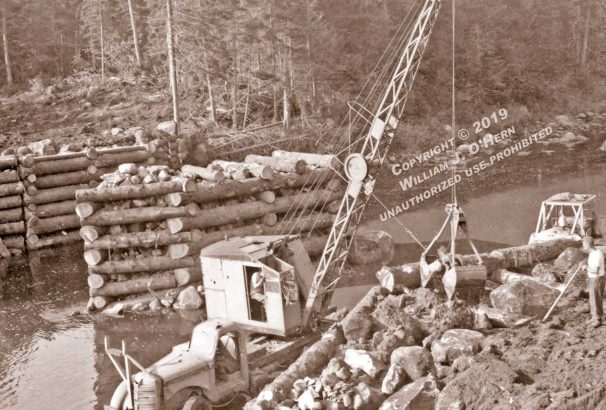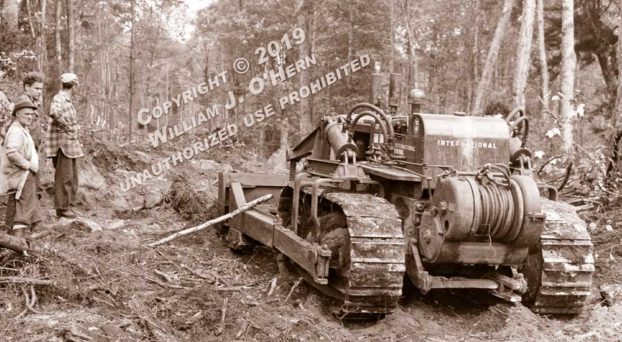The first time I met William J. “Jay” O’Hern, it was in The Northern Logger offices in Old Forge, New York.

A Look Back In Time
In Conversation with Adirondack Author William J. O’Hern
An article by Eileen Townsend printed in “The Northern Logger “, June 2021
The first time I met William J. “Jay” O’Hern, it was in The Northern Logger offices in Old Forge, New York. The Northern Logger keeps an archive of old publications, dating back to 1939, in our basement, and O’Hern was in the office for research purposes. At the time, he was hard at work compiling the stories and photographs that now make up his 500+ page book, Adirondack Timber Cruising. O’Hern is a prolific author whose work is well known in the Adirondacks, and his interests aren’t limited to logging. But he has written several informative and richly detailed volumes that catalogue the lives and times of Adirondack foresters and loggers. The topic clearly remains a compelling one for him.
As the title suggests, Adirondack Timber Cruising is about the development of timber cruising, logging, forestry and our relationship to our physical environment. In the book, through narratives of everyday lives, O’Hern attempts to show that conservation is concerned with our spiritual and mental as well as our material welfare. It is not enough to use forest resources wisely, with the idea that forestry is an end in itself, but rather the end is greater human happiness through wise forest management. O’Hern’s book is concerned with the people who lived and worked in the timber woods before chainsaws and trucks, who witnessed firsthand how mechanization changed everything.
I spoke with O’Hern about his fascination with logging culture and what drew him to write Adirondack Timber Cruising, which followed his earlier book on logging, Life in a North Woods Lumber Camp. As of 2021, the prolific author is looking toward is fourth volume on logging, called The Adirondack Logging Industry. He said that he never meant to write three volumes on the subject, but after he got started, there was simply too much history to relay. As is usually the case in the timber industry, the work continues.

Construction of a bridge over the Indian River in the Moose River Plains by Gould Paper Company, circa. late 1940s.
This interview has been edited for length and clarity.
Northern Logger: What first interested you in writing about logging?
Jay O’Hern: It had to do with my first occupation. When I was 21, I worked at a sawmill in New York. It was hard manual work, but for one reason or another, I enjoyed the work. Listening to the older fellows talk got me more interested in the cycle that the industry had gone through over the decades from horse logging to mechanization. I only worked there for about a year. Unfortunately, their debarker caught fire, the mill burned to the ground, and I moved on. But I was hooked on logging after that. Once I moved to Camden, New York, I met a lot of people who were loggers or former loggers and worked in logging camps. Hearing their tales helped turn back the time and took me away – turning back the years. There were no books to document their memories. These people were dying, and with them the human history.
I started interviewing with really no idea of writing. But as more and more of them passed away, I thought, I’ve got to do something with their stories because I owe it to their memory. So, I just embarked on writing. Luckily, I had written some other books. I’m not trained as a writer at all, but based on my experience with the process of writing, I knew I could put together books that would carry on the life of the people who had passed away.
NL: You’re obviously a very thorough researcher. What have you learned about the relevance of historical research today?
JO: One thing I noted talking to older loggers is how much enjoyment they expressed about their work. It didn’t matter how hard the manual labor was or whether they used powered machinery. They loved their work. Maybe the average person thinks about logging, “Why would they like this kind of work? It’s so darn hard and demanding!” But, as I learned in these interviews, it was just something that they cherished. They also cherish the fact they wanted to have a sustainable supply to timber.
NL: What draws you to writing about everyday life?
JO: I’m fascinated by the memorabilia. I love thinking about how the logging industry has changed over time. There are men and women involved in the logging industry who worked with oxen, then horses, and then from there went to mechanical machinery. I know a number of people who collect vintage logging machinery and equipment. I’ve gone on several trips to unearth what I call “the ghosts of logging.” In fact, one logger called me last night and said he heard there was a Linn tractor back in the woods. I’ve gone on these bushwhacks for years, hunting for these ghosts that are supposed to be left back in the woods. Most of the time we don’t find them. But there have been gems we have found. Loggers and even people who aren’t loggers can appreciate the early machinery and how it functions. I meet people at book signings with white collar occupations and no connection to the logging world at all, but they’re just interested! I’m happy to have put the books together because everything that I’ve collected would have been gone if it hadn’t been published, and people would know very little about the everyday lives of these folks.
NL: Based on your historical knowledge of the Adirondacks, where do you think the industry is headed today?
JO: I’m hopeful that it is headed in a good direction. I’ve seen so many forests that were under the protection of various logging companies go back to “Forever Wild.” But I think the industry is smart enough to survive whatever comes its way. No matter how big and expensive the machinery is, we know we’re going to have logging. For the most part, I think companies that now have large preserves are looking toward the future. That’s only based on what I see around around New York’s Tug Hill region. It’s changing a lot because one man can do the work of many men in the past, and it’s getting very expensive for that one- or two-man operation. You see the cost of the equipment is hundreds of thousands of dollars, and you only hope that the logger isn’t going to destroy the property for the initial cash out.
NL: What else should our readers know about your work?
JO: I love including pictures in my books! Pictures can say a thousand words, and I have been fortunate to be able to collect a large number of pictures taken mostly by people who were in the woods. People want to have books with pictures to help visualize the logging industry, to understand the lifestyle, the hardships and the interest they have in doing that type of work. I want my legacy to be that I’ve taken the time sharing these people’s lives and their type of work and how the industry has changed. That’s the history in me, the history of the average man and woman. You can find political history all over, but you can’t find the kind of human history that I’ve done, which is about the common day people.
When developing my books, I experienced lumber camp life, accounts of river drives, the passing of old-style logging with oxen and horses, shared their remembrances, learned about the rise of diesel and gas-powered machinery and even prepared some popular camp recipes. How cool is that? And, while decades have passed, I still picture Norm Griffin in Camp 9’s bunk room talking about hula girls and his plan of flying to Hawaii; then old George’s story of how he swore the camp cook eliminated gas from his bean soup. There was Ed Raymond’s tale of an American bedbug; tough Rita Chisson’s rules that kept the lumberjacks in line during mealtime. I could go on and on about the work, accidents, light-humored moments and white-water tragedies. I think Conse Delutis expressed the admiration toward all lumberjacks best: “They were a sturdy, hard-talking lot with hearts of gold, men who would give you the shirt off their back if you needed it but show you no mercy if you tangled with them. Men [and women] you’d like to know.”
During the writing process, I also did a lot of thinking about my pastoral homeland and asking, “How important is protecting open space and the nation’s forests for tomorrow’s children?” I confess I am heartsick when longtime farms shut down and plant and wildlife habitat is destroyed with each new development. People must strike a balance between abundant lives, the natural world and leaving a heritage for future generations.

The Gould Lumber Company followed strict standards when developing their haul road that reached deep into the Moose River Plains